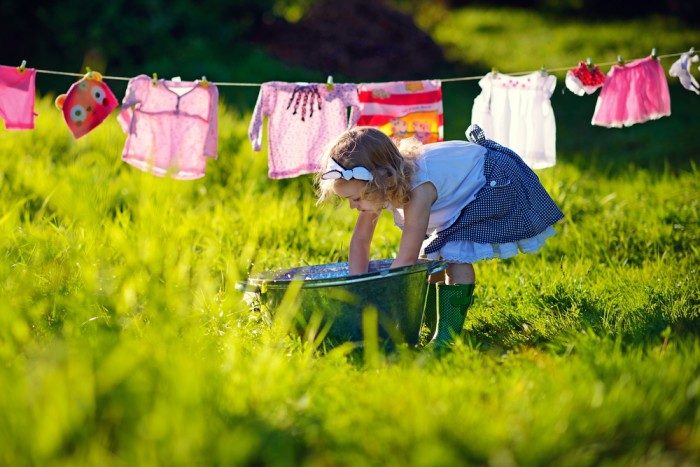A Guide to Cleaning Natural Fabrics

In an effort to live sustainably I’ve overhauled every aspect of my life, including my wardrobe, shunning rayon, polyester, and Spandex in favor of natural fabrics—wool, cotton, silk, and linen—mostly linen. Whenever possible, I buy textiles dyed with plant-based, not synthetic, dyes.
Quality natural fabrics cost more than their synthetic cousins, so it pays to care for them properly. Surprisingly, I’ve found I need fewer items in my wardrobe and my clothing lasts longer so I end up spending about the same amount of money in the end. As with anything of quality, I enjoy natural fabrics more. They have a casual elegance—and they just feel better.
When laundering natural fabrics you don’t need detergent. A mild, neutral soap does just fine. Although Woolite is often recommended, I don’t use it due to environmental and health concerns. The Environmental Working Group has a good guide to truly eco-friendly laundry soaps. Search the site www.ewg.org, and choose an A-rated product.
Switching to all-natural fabrics has been a slow process—an interesting journey with many lessons. Here are 10 tips I’ve gleaned along the way:
• Wash Lightly: A front-loading washing machine is much easier on fabrics that a top-loading agitator type. While I use the washing machine for everyday items, I hand wash my favorite textiles. It’s a ritual I enjoy.
• Hang it Up: Clothes dryers are extremely hard on all fabrics. Make your clothes last longer by hanging them to dry either indoors on a wooden rack or outdoors on a line.
• Cotton Wisdom: Conventionally grown cotton uses more insecticides than any other single crop. Organic cotton makes more sense, from the health benefits for individual growers to the ecologic stewardship of farmlands for future generations. Care for organic cotton in the same way you would any other cotton textile. If not pre-shrunk, wash in cool water.
• Drying Differences: Cotton may be either hung to dry or tumbled at moderate heat. Silk should be hung to dry. Wool items should be hand washed in cool water and laid flat to dry. All fibers can be finished with a light steam press.
• Handwoven Care: Handwoven cloth has special magic and beauty, but it is delicate and needs extra care. It should be hand washed with cool water and mild neutral soap and then laid flat to dry.
• Handling with Care: Embroidered or stitched garments should be washed by hand in cool water with mild neutral soap.
• Caring for Plant-Dyed Fabrics: Wash plant-dyed textiles with mild neutral soap in cool water. Because these dyes are often not colorfast, wash items separately and turn them inside out. Do this before wearing, too, to help set the hue. If you hang them outdoors to dry, don’t let them sit in the sun too long or they will fade.
• Linen Lowdown: Wrinkled linen has a casual devil-may-care elegance. If you aren’t too picky you can eliminate ironing by smoothing out wrinkles before hanging to dry.
• Maintaining Texture: To retain the nature of sculptured cloth, it is absolutely necessary to dry clean only and do not press. If the texture is not essential, hand wash in cool water with a mild neutral soap, roll in a towel to remove excess moisture, and hang to dry.
• Green Dry Cleaning: It may take some searching to find a green dry cleaner in your area, but it’s worth the effort and you’ll be doing your part to keep toxic chemicals out of the environment. Traditional cleaners still use perchloroethylene, labeled carcinogenic to humans by the EPA, and its disposal must be handled as hazardous waste. The solvent will be illegal in California by 2023, but we’re not quite there yet.



May 14th, 2014 at 5:35 pm
[…] First published in Green Cleaning Magazine […]
July 4th, 2014 at 3:58 am
[…] First published in greencleaningmagazine.com. https://greencleaningmag.com/a-guide-to-cleaning-natural-fabrics/ […]